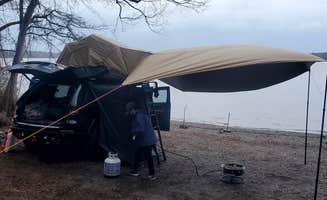Dispersed camping near Montpelier, Virginia primarily centers around Wildlife Management Areas (WMAs) located within a 30-mile radius of the region. These areas feature coastal plain ecosystems with mixed hardwood forests and riverside camping opportunities along the Chickahominy and James Rivers. During spring and fall, humidity levels remain moderate while summer months can bring temperatures exceeding 90°F with high humidity, requiring campers to prepare accordingly.
What to do
Fishing opportunities: At Eagle Nest Lookout, fishing is particularly productive with some impressive catches reported. One camper noted, "If you are fishing, they pulled up a 17 pounder and a 25 pounder using a drone to take their lure easy out and someone caught a decent bass." The James River access points provide excellent opportunities for both shore and boat fishing.
Hiking trails: Chickahominy Wildlife Management Area offers several unmarked trails through coastal forest terrain. The property encompasses over 5,200 acres of primarily forested land in the tidewater region, providing ample exploration opportunities.
Wildlife observation: The WMAs support diverse bird populations, particularly during migration seasons. Bring binoculars during spring months when songbird activity peaks. Ware Creek Wildlife Management Area offers quiet observation points with minimal human traffic, as one visitor mentioned, "Take advantage of your local wildlife areas."
What campers like
Waterfront access: Many dispersed sites offer direct water access, which campers consistently rate as a top feature. One visitor to Eagle Nest Lookout reported, "Car camped here 5 feet from the water. There is a large shoreline area to Car camp and right up the hill is a nice tent site as well overlooking the river."
Multiple site options: The WMAs provide various camping spots to match different preferences. A camper at Chickahominy WMA explained, "This place has about 15 cleared areas any one of which I would have been happy with. As a bonus there is a raised area—about 20' above the drivable area—that would be perfect for a campfire and a tent or two."
Solitude potential: While weekend fishing traffic can increase, weekday visitors often find complete solitude. One visitor to Eagle Nest Lookout noted, "Definitely a busy little spot but we ended up having the place to ourselves once all the people Fishing left."
What you should know
Permit requirements: Virginia WMAs require either a $4 daily use permit or a valid Virginia hunting/fishing license. A Chickahominy WMA camper clarified, "Camping here is free but there is a $4 daily use fee to be in the WMA that you can pay via phone, website or app tho the clunkiness of the website and app make it hard."
Trash issues: Unfortunately, many sites suffer from litter problems requiring campers to arrive prepared. As one visitor stated, "There was quite a bit of trash dispersed in this area in which we picked up. Apparently this is a well used fishing location seen by the debris that was left."
Noise considerations: Nearby shooting ranges affect the soundscape at certain sites. A visitor warned, "We stayed down by the boat ramp. There are basically two parking or camping spot closest to the ramp partitioned by some rail timbers...Be aware that you will be able to hear the shooting range up till the evening."
Tips for camping with families
Site selection priority: Choose elevated sites at Eagle Nest for better supervision of children near water. The knoll area provides a safer alternative to the immediate shoreline sites. One camper described, "There is a beaten narrow path that leads from the end of the road up to a small knoll. At the top is an area about 20 feet wide covered in mature trees with a view of the James River."
Timing considerations: Weekday visits significantly reduce encounters with other users, particularly hunters during season. Winter camping offers greater solitude as noted in one review: "Car camped here 5 feet from the water...If your looking for complete privacy, I'd recommend trying one of the other sites sprinkled around the area."
Water safety: No lifeguarded areas exist at any of the WMAs, and water currents can be strong, particularly after rainfall. Bring personal flotation devices for any water activities.
Tips from RVers
Access limitations: Small trailers under 20 feet can access some waterfront areas, but larger rigs should avoid these dispersed sites. A camper with experience noted, "I arrived with a small (18') trailer and put it within 5' of the water."
Site conditions: No hookups or amenities exist, requiring complete self-sufficiency. Leveling blocks are essential as most sites have uneven terrain. Sites remain primitive with minimal improvements.
Generator etiquette: Some campers report inconsiderate generator use disrupting the natural setting. One camper complained, "One relieved himself at his truck on the side We were on and moved on the side with the larger group of cars, truck and campers. To add insult to injury this group ran their generators up until 4:30 am."


